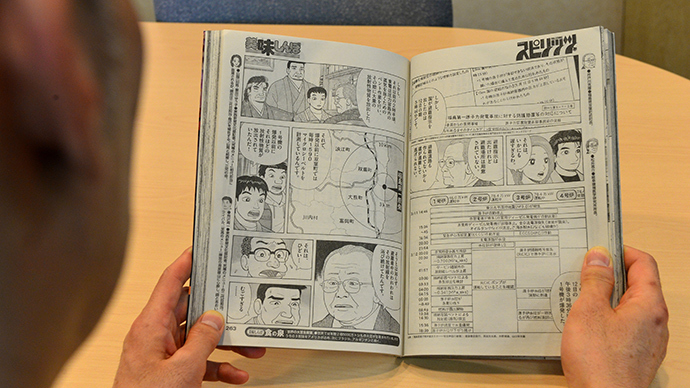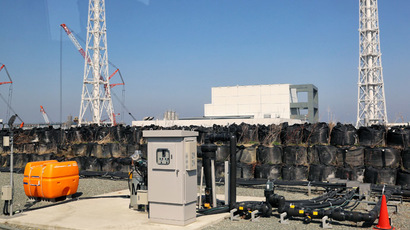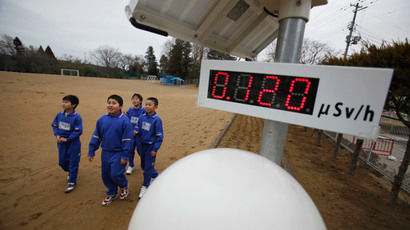Fukushima radiation message in popular manga sparks political firestorm

A long-running cooking manga best known for the adventures of a culinary journalist has gotten into hot water with the central and local government, with its less than stellar depictions of the Fukushima nuclear disaster.
In the latest “Oishinbo", a mashup of the Japanese words “delicious” and “gourmand”, a character based on the real former Futaba Mayor, Katsutaka Idogawa, warns that many locals suffer from symptoms of radiation exposure.
Idogawa also criticizes the responses from plant operator, the Tokyo Electric Power Co. (TEPCO) and the central government to the worst nuclear disaster in Japan’s history. Futaba is one of two municipalities that host the crippled Fukushima Daiichi nuclear power plant.
Another character portraying Takeru Arakida, associate professor at Fukushima University, says Idogawa reached his conclusions after heavy consideration and reflection which were “immune from any lie or falsehood and are weighty,” the Japan News reports.
“You simply can’t decontaminate a wide area in Fukushima and make it a place where people can live again,” Arakida says in the manga. “This is the truth of Fukushima,” another character responds.
In another issue published on April 28, the main character in the series, Shiro Yamaoka, suddenly developed a nosebleed after visiting the crippled Fukushima No. 1 nuclear power plant.
Both depictions have struck a raw nerve with local politicians and national figures alike.
On Monday, the prefectural government of Fukushima posted on its website the “feelings of the Fukushima people were totally ignored and deeply hurt," Japan’s Asashi Shimbun reports.
"The depiction could severely damage the agriculture, forestry, fisheries and tourism industries."
The prefectural government submitted a formal protest against Shogakukan Inc., the publisher of the manga weekly, for the nosebleed scene, saying that "there have been no confirmed cases of direct damage to health caused by radioactive materials emitted from the nuclear accident."
“We . . . definitely cannot tolerate (the descriptions). It’s extremely regrettable,” the Fukushima government said.
In a separate statement, the Osaka Prefectural Government was angered by a claim made by another character based on a real-life medical expert, Eisuke Matsui. In the comic, Matsui is depicted as saying that around 800 people living around an incinerator there have been affected by burning tsunami debris tainted with radiation.
The Osaka Prefectural Government claimed that no local doctors or authorities have received reports of ill health due to the 15,300 tons of tsunami debris burned in the western Japanese city of Osaka.
Osaka Mayor Toru Hashimoto told reporters: "Because of freedom of
expression and since it is a manga, fundamentally the artist can
freely do what he wants, but I think he went overboard with the
depiction that has no basis in fact."
Politicians on the national level also weighed in on the
politically charged manga.
At a news conference on Monday, Chief Cabinet Secretary Yoshihide Suga said experts had denied any causal relationship between nosebleeds and exposure to radiation following the March-2011 Fukushima Daiichi nuclear disaster.
"It has been made clear through the appraisal of experts that there is no causal relationship between radiation exposure among residents and nosebleeds."
Suga said that while the government will continue to disseminate accurate information based on scientific evidence, it will not lodge a complaint with either the publisher or the author, citing free speech.
Environment Minister Nobuteru Ishihara echoed Suga’s statement on Friday.
Meanwhile, Ruiko Muto, who heads a group of plaintiffs who have filed a lawsuit seeking criminal responsibility for the Fukushima nuclear accident, said incidents of nose bleeds were not unheard of, despite government efforts to shout down the depiction.
"After the accident, I heard that some people suffered from nosebleeds. It is a fact that radioactive materials exist so a definitive statement cannot be made about no causal relationship. I feel uncomfortable with the concerted effort to protest the depiction of the nosebleed segment," Asahi Shimbun reports.
Following the deluge of criticism, the publisher posted a comment on its website saying the episodes “have not asserted” that the symptoms were definitively caused by radioactive materials from the Fukushima plant, the Japan Times reports.
Shogakukan said it plans to carry “a special feature article” next week, summarizing the opinions of various experts and readers, including critics, on its website.














